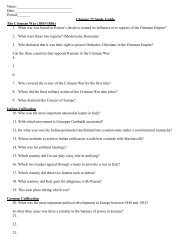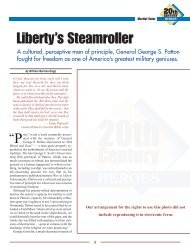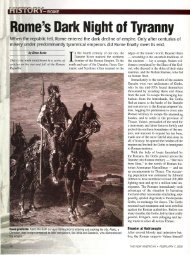The Lindbergh Baby Kidnapping Mystery - Home
The Lindbergh Baby Kidnapping Mystery - Home
The Lindbergh Baby Kidnapping Mystery - Home
You also want an ePaper? Increase the reach of your titles
YUMPU automatically turns print PDFs into web optimized ePapers that Google loves.
<strong>The</strong> Police Response<br />
<strong>The</strong> police suspected an “inside job.” <strong>The</strong><br />
kidnappers knew where the baby’s nursery<br />
was. Furthermore, the <strong>Lindbergh</strong>s always<br />
stayed at the Morrow mansion in Englewood,<br />
New Jersey, on weekdays, while<br />
building their own home in distant rural<br />
Hopewell, where they stayed weekends as<br />
construction finished. On the week of the<br />
kidnapping, however, the baby came down<br />
with a cold, and the <strong>Lindbergh</strong>s decided<br />
to remain longer at Hopewell. Without a<br />
tip, the kidnappers shouldn’t have known<br />
about this variation in routine. <strong>The</strong> baby<br />
was snatched on a Tuesday.<br />
Suspicion fell on Violet Sharp, a Morrow<br />
maid. Sharp had taken Anne <strong>Lindbergh</strong>’s<br />
phone call about the change in<br />
plans. She lied to the police about her<br />
whereabouts the night of the kidnapping,<br />
saying she went to the movies —<br />
but couldn’t recall the film or her date’s<br />
name. On subsequent interrogation, she<br />
said she actually visited a roadhouse with<br />
an Ernie Brinkert — but Brinkert denied it.<br />
After the baby’s corpse was found, Sharp<br />
became increasingly disturbed. When the<br />
police came to question her again, she was<br />
dead, having swallowed cyanide. Oddly,<br />
a different “Ernie” later corroborated her<br />
roadhouse alibi. Today, investigators of<br />
the kidnapping still debate the reason for<br />
Sharp’s suicide — or was it even murder?<br />
Another evidence of “inside help”: Police<br />
found no fingerprints in the nursery<br />
— not even the child’s, his nurse’s, or the<br />
AP Images<br />
<strong>Lindbergh</strong>s’. Eventually, Dr.<br />
Erastus Hudson — pioneer<br />
of a silver nitrate fingerprint<br />
process — lifted latent prints<br />
from the nursery. Hudson<br />
stated the only explanation<br />
for the missing fingerprints<br />
was someone methodically<br />
wiping down the nursery<br />
after the abduction. It hardly seemed likely<br />
the kidnappers waited around to do this.<br />
At the time of the crime, five adults were<br />
in the house — Mr. and Mrs. <strong>Lindbergh</strong>,<br />
the baby’s nurse, the cook, and butler.<br />
Only the butler, Oliver Whateley, was unobserved<br />
during the kidnapping. And like<br />
Violet Sharp, Whateley died suddenly, in<br />
1933 of peritonitis.<br />
Heading the investigation was New Jersey<br />
State Police Superintendent H. Norman<br />
Schwarzkopf — father of “Stormin’<br />
Norman” of Gulf War fame. A “political”<br />
appointee, Schwarzkopf’s only criminal<br />
justice experience before this position was<br />
as a department store floorwalker. President<br />
Herbert Hoover ordered federal agencies<br />
to assist the investigation — a process facilitated<br />
when Congress made kidnapping<br />
a federal crime. J. Edgar Hoover offered<br />
the superior criminology resources of the<br />
Bureau of Investigation (BI — later called<br />
FBI), but Schwarzkopf refused. While some<br />
might commend this as keeping police independent<br />
of federal intrusion, Schwarzkopf<br />
also rejected<br />
<strong>The</strong> ctm: <strong>The</strong> first of the ransom notes for Charles Augustus <strong>Lindbergh</strong>, Jr. bore an occultlooking<br />
“signature.” <strong>The</strong> writing was crude — or designed to look that way.<br />
all U to suscrie toda<br />
After the baby’s corpse was found, Sharp<br />
became increasingly disturbed. When the<br />
police came to question her again, she was<br />
dead, having swallowed cyanide.<br />
local assistance. New Jersey’s Governor authorized<br />
the state’s most famous detective,<br />
Ellis Parker, to help. Known as “America’s<br />
Sherlock Holmes,” Parker had solved over<br />
200 murders. Yet Schwarzkopf declined,<br />
saying Parker was not in his jurisdiction.<br />
Since the kidnapping went unsolved for<br />
over two years, Schwarzkopf’s refusal of<br />
top resources was sharply criticized.<br />
Investigation focused on tracing ransom<br />
bills, which appeared in a trickle. Since<br />
most were passed in New York City —<br />
outside Schwarzkopf’s own jurisdiction<br />
— this entailed interagency cooperation.<br />
Tracing money was difficult, however;<br />
few cashiers delayed customers to check<br />
serial-number lists. Most was found when<br />
later turned in at banks, but efforts to trace<br />
bills to original passers either failed or located<br />
someone cleared of suspicion.<br />
A Suspect at Last<br />
<strong>The</strong> case broke in September 1934. A<br />
Bronx carpenter, Bruno Richard Hauptmann,<br />
passed a $10 ransom bill at a gas<br />
station. Police found about $14,000 more<br />
in ransom money hidden in his home.<br />
<strong>The</strong> German-born Hauptmann told<br />
police he’d discovered the $14,000 in<br />
a box left with him in December 1933<br />
by an associate, Isidor Fisch, who’d<br />
gone to Germany where he died of<br />
tuberculosis. (Fisch had indeed been<br />
in a joint venture with Hauptmann and<br />
died in Germany.) Fisch’s brother was<br />
coming from Germany to settle the estate.<br />
Hauptmann meanwhile decided<br />
to spend some of the cash he’d found<br />
— Fisch owed him over $7,000 anyway,<br />
and Hauptmann said he didn’t know it<br />
was ransom money.<br />
<strong>The</strong> police, however, dismissed Hauptmann’s<br />
explanation as a “Fisch story”; he<br />
was extradited to New Jersey for trial. In<br />
newspapers, the case appeared open-andshut.<br />
Hauptmann had entered the United<br />
States as a stowaway, with a prison record<br />
in Germany for robberies. John Condon<br />
33













